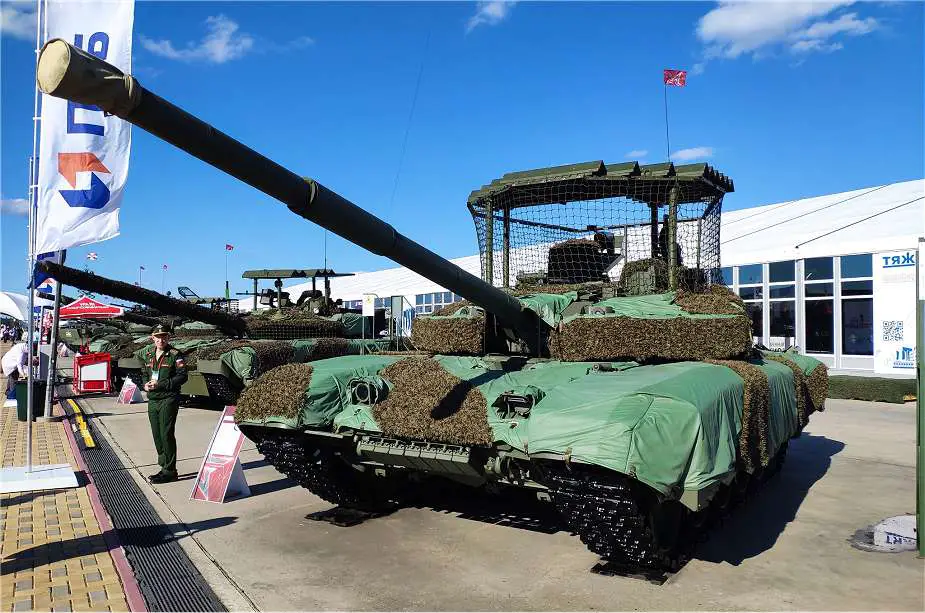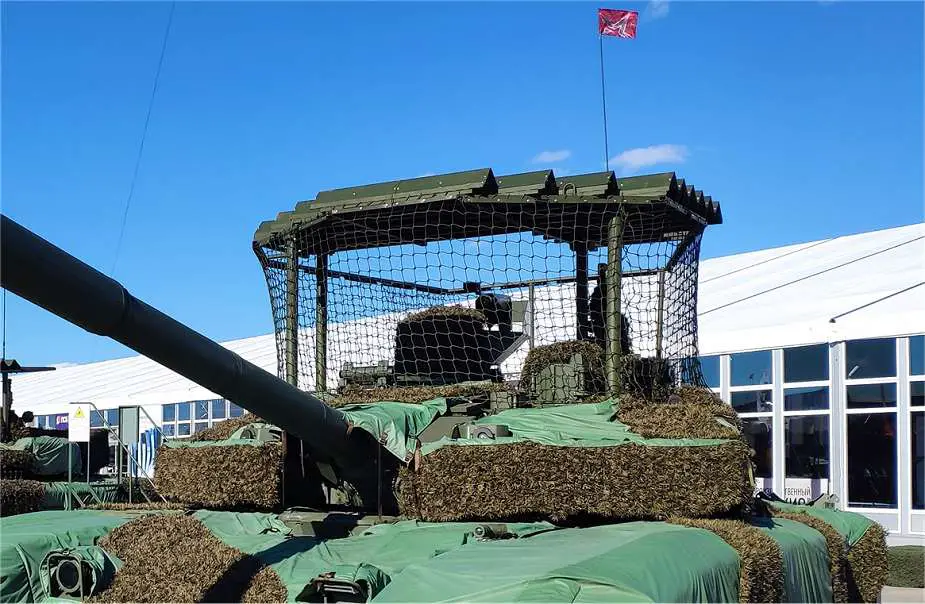Breaking news
Army-2023: Russia Unveils T-90M Tank Upgrade with 'Cope Cage' for Enhanced Drone Defense!.
At Army-2023, a defense exhibition that was held in Moscow from 14 to 20 August 2023, Russia presented a new variant of the T-90M fitted with a "Cope Cage" or "Protective Canopy" and metal mesh mounted on the roof of the turret to increase protection against drones and loitering munitions attacks.
Follow Army Recognition on Google News at this link

Russian T-90M MBT Main Battle tank fitted with new Cope Cage. (Picture source Vitaly Kuzmin)
The Cope cage mounted on Russian Main Battle Tanks (MBTs) as well as other combat vehicles first appeared during the war in Ukraine to respond to the new threats on the battlefield and especially to increase protection against loitering munitions, suicide drones, or FPV (First Person View ) kamikaze drones. The cope cage consists of in the form of a screen mounted on several tubular poles attached to the tank’s turret.
A First Person View (FPV) kamikaze drone is a type of unmanned aerial vehicle (UAV) that is equipped with a camera that provides a live video feed to the operator, allowing them to pilot the drone from a first-person perspective. The term "kamikaze" in this context refers to the drone's ability to carry out a one-time mission where it intentionally crashes into a target, delivering a payload upon impact.
In the evolving landscape of the Ukraine conflict, drones and loitering munitions have emerged as significant game-changers, posing heightened threats to armored vehicles, including the tanks of the Russian army.
The US Army, recognizing the potential of these unmanned weapons, is fast-tracking the development of its own tank-killing drone under the LASSO (Low Altitude Stalking and Strike Ordnance) program. Designed to be man-portable and tube-launched, LASSO aims to engage non-line-of-sight targets and armored vehicles with lethal precision. The urgency of this project is underscored by its classification as an "urgent capability acquisition," signaling the U.S. Army's intent to field this new weapon in under two years.
Loitering munitions, often described as a hybrid between drones and guided artillery shells, have been particularly effective. Lightweight and equipped with both a warhead and a camera, they can survey an area, sending back real-time imagery to operators who then decide on the optimal moment to strike. Ukrainian forces have showcased their ingenuity by converting commercially available quad-copters into suicide drones, targeting Russian armored vehicles and artillery units. In response, Russia has deployed its military-grade Lancet 3 loitering munitions, focusing on Ukrainian artillery positions and disrupting their counteroffensives.

The T-90 M is fitted with a top cage armor including a metal mesh covering the turret on 360°. (Picture source Vitaly Kuzmin)
Adding another layer to this aerial chess game, Russia is reportedly pioneering the development of the "Joker FPV loitering munition." This drone boasts a unique hibernation feature, allowing it to lie dormant for extended periods, evading electronic countermeasures. Once activated, it can swiftly strike, reducing reaction times and potentially catching adversaries off-guard.
Economic considerations have also played a role in the choice of weaponry. The US has supplied Ukraine with over 700 Switchblade loitering munitions. However, their price tag, ranging from $58,000 to $80,000 each, stands in stark contrast to Ukraine's militarized commercial drones, which cost merely a few hundred dollars each. This cost disparity has tilted the economic advantage in favor of the more affordable drones.
The anti-armor capabilities of these drones have been a focal point of their deployment. Videos circulating on social media platforms show Ukrainian drones targeting Russian tanks. These attacks, often using improvised weapons, aim for the tanks' thinner top armor, exploiting a known vulnerability. The LASSO program, too, is believed to be targeting this weak point.
In response to emerging threats, the Russian defense sector suggests a new Protective Canopy for the T-90M tank turret. This canopy is essentially a screen supported by several cylindrical rods affixed to the tank's turret. The canopy's top combines a metal grid (which seems to maintain visibility from the tank's hatches when open) with a distinct wavy metal covering. The purpose of these alternating ridges is not entirely clear, but it's speculated that this design might be more adept at warding off drone-released mortars or FPV 'suicide' drones. This concept mirrors the v-shaped hulls used in mine-resistant vehicles.
There are evidently different designs for this tank protective canopy, some with additional support rods and a broader wavy metal surface. The canopy's 'sides' can also be draped with a mesh to shield against side-turret attacks. This same mesh is positioned between the turret and the tank's body, aiming to block drones from accessing this potentially weak spot.
Defense News August 2023























